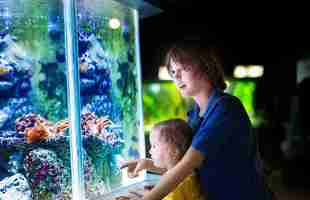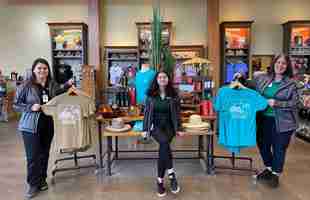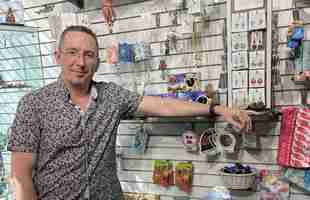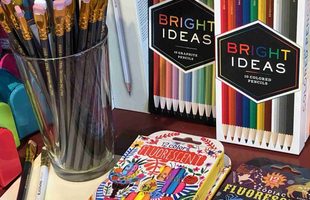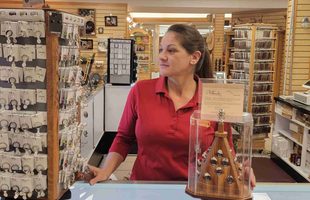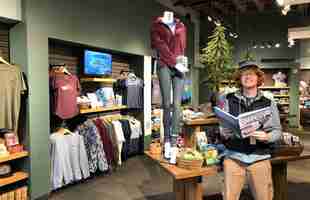According to staff at zoos and wildlife sanctuaries in a wide range of locations, souvenirs at zoos and animal attractions typically do well – if the items represent the animals that guests experience. Helping to make memories from animal interactions is a key factor when it comes to what souvenir items are top sellers.
At the Heritage Park Zoological Sanctuary located in Prescott, Ariz., Gift Shop Supervisor Tessa Gillette said her best-selling souvenirs are plush figures. “We have a lot of plush animals that represent the animals we have here. We also do well with name-dropped T-shirts, mugs, and magnets,” she related. Selling more souvenirs is based on merchandising, online marketing, and themed and well-organized displays, she explained. “Our marketing department does a little bit of everything, and we do have posts online. In the store, we merchandise specifically for our zoo animals. We have items together that are themed by the type of animal, and we also have other sections in the store, such as a children’s area. We have many parents coming in with children, so we have an appealing toy section that is merchandised and set up accordingly, including a small event area for the very young ones.”
“Our T-shirt which says ‘I Kissed a Giraffe’ is also a big seller. Sometimes our giraffe will lean over and kiss you, so the T-shirt really represents that experience.”
– Mary Schmidt, Out of Africa Wildlife Park, Cape Verde, Ariz.
Over time, Gillette said she hasn’t seen that much change in the overall souvenir picture. “Honestly, everything is pretty much the same. Children still love the plush, as well as toys such as small animal transport cars and animal puzzles. People are always looking for something that represents the zoo experience, and many tourists who come in are looking for collectibles, such as shot glasses or magnets. That type of buyer collects similar items from many locations, and they are interested in ours when they visit. That hasn’t changed.”
Also in Arizona, at the Out of Africa Wildlife Park located in Cape Verde, Gift Shop Manager Mary Schmidt agreed that stuffed animals are a top seller when it comes to souvenirs. “Our T-shirt which says ‘I Kissed a Giraffe’ is also a big seller. Sometimes our giraffe will lean over and kiss you, so the T-shirt really represents that experience.” She noted that while the majority of the venue’s plush are not name-dropped, they do “represent the zoo, because they are figures of the animals that we have here.” To sell more souvenirs, Schmidt follows a similar course to that at Heritage Park: “Displays, social media, and interacting with guests all play a big part.” According to Schmidt, “Our guests can, for example, go and meet our sloths, have a sloth encounter. If they’ve participated in that, then our sloth-themed items do very well. If the park owner is here doing a giant snake show, then the snake items sell well. In the store, we have a featured animal of the month every month, which we present in a separate display area. We have an old suitcase that opens up, and we pick five to 10 facts about that animal and have cards that describe those, as well as a picture of our own location’s animal. Within that display area we have T-shirts, plush, toys, whatever relates to that specific animal.” Additionally, she added, “we post on Instagram and Facebook about the animals and the merchandise that we have related to them. People do come in and are more interested in buying merchandise that is focused on those animals presented in that media.”
Asked how the souvenir picture has changed over time in her 1,000-square-foot store, Schmidt said, “Jewelry isn’t doing great for us anymore. It is the least-selling item in the shop. We sell everything from home décor to toys to clothing to Christmas ornaments, and the one item that just doesn’t do as well now is jewelry.” The other trend that she’s noticed is that “Certain items, such as holiday ornaments, always sell better when they are name-dropped.” She also said visitors are more and more interested in bringing home a souvenir that reminds them specifically of their visit to a location.
In Imlay, Nev., at Safe Haven Wildlife Sanctuary, CEO and Founder Lynda Sugasa described her gift shop’s top-selling souvenirs as “T-shirts that have one of our rescued animals on it, calendars with our animal photos on it, and jumbo animal magnets, in that order.” Selling more souvenirs at Safe Haven is also about the experience visitors have at the attraction. Sugasa added, “Once people have become engaged or interested in a particular animal, they like to have souvenirs that include that animal.” As to changes in the souvenir picture overall, Sugasa, too, notices no major changes, but asserted, “The T-shirt sales seem to be the most consistent from year to year.”
“ …For us, anything sloth-related is going to sell well, and we have everything from baseball caps to backpacks with sloths on them. A very big seller for us are stuffed animal sloths.”
– David Riherd, Wildlife Learning Center, Sylmar, Calif.
At Wildlife Safari in Winston, Ore., Gift Shop Supervisor Debbie Sickels said her store offers “a good healthy mix” of merchandise of all kinds, all of which are attractive to visitors. “We have shot glasses, coffee cups, crystal ornaments, and our very best sellers, which are animal art work. The art is created by the animals themselves.” She explained, “We’ve introduced painting and other art work to keep the animals entertained. Just as elephants will pick up sticks and draw in the dirt, they will paint with paint brushes. We also have giraffes, and cheetahs that all create art work.” As at other zoos and sanctuaries, at Wildlife Safari, selling more souvenir items is based on guests’ interactions with various animals, as well as on displays in the store, and social media posts. “We have lots of information up on our website. We have many different encounters at our facility that allow guests to see the animals up close. In regard to the animal paintings, guests can even commission a piece by color or ask for a painting made by a particular animal.” Sickels’ in-store displays include a video monitor that shows animals creating the paintings available in the gift shop, which heightens interest in the painting souvenirs. “I do group thematically as well as by like-items,” she said. “We have tables up in the front of the store that have items such as all the cheetah artwork or all the elephant ornaments and other merchandise together. But primarily, throughout the store everything is organized by item type rather than by theme or animal; for example, we group all our T-shirts and hoodies together.”
Sickels has been at the venue for three years, and during that period, she said she has not seen that much change in the souvenir-purchasing picture. However, she noted that “Today, people like to know a description of how an item is made, what is behind it. They have their own favorite animals or a real love for one or another animal. And they also like to know that when they buy items, the profits go back to the benefit of the animals, to create a better living space for them, and that type of thing. That interest has grown stronger.”
Interest in animal welfare and receiving information about an animal depicted on souvenirs is also important at the Wildlife Learning Center in Sylmar, Calif. Center Director David Riherd said top-selling souvenirs at the venue’s 600-square-foot gift shop include “T-shirts, plush animals, mugs, tote bags, and animal-themed bookmarks and change purses. That said, for us, anything sloth-related is going to sell well, and we have everything from baseball caps to backpacks with sloths on them. A very big seller for us are stuffed animal sloths.” For Riherd, too, interaction with guests at the facility are a big boost to souvenir sales. “We’re not aggressive about selling, and we don’t do any advertising or specific promotion about our gift shop. We emphasize information about the animals, and we do thematic displays in the shop, such as grouping all of our sloth items together.”
The change that he noted as happening over time is that today “People are looking more for a memory of an experience as a souvenir, so they really want to take home something that is related to a personal interaction with an animal that they saw or met. A mug or a T-shirt or a picture of an animal they enjoyed, that kind of reminder of a personal experience, that’s what they want to take home today.”
